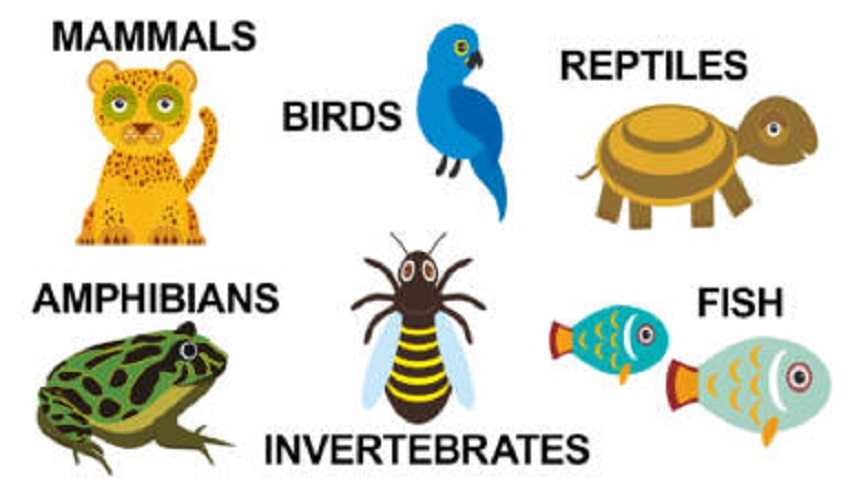7,770,000. According to the latest research, this is the estimated number of animal species that inhabit the Earth. In any case, of these 7.77 million species, a little over 950,000 are currently described.
Therefore, despite knowing an incredible number of different animal species, there are still more than 88% undiscovered, with the marine ones remaining the most secret.
The richness and variety of animals on our planet are enormous. For this reason, biology has devoted a great deal of effort to taking all these hundreds of thousands of species and dividing them into different groups.
In today’s article, we will see this classification, detailing the characteristics of all these species in the different groups.
How are living things classified?
what is a living being? Ironic as it is, something so natural and seemingly easy to answer continues to be one of the biggest problems for biology.
Broadly speaking, we can consider a living being as any structure made up of cells (although there are organisms made up of only one) that, through communication systems and organs and/or tissues, make up an organism with the ability to nourish itself, interact and reproduce.
And this includes from the simplest bacteria to ourselves, through plants, algae, fish, jellyfish, dogs, fungi, parasites, and even sea sponges.
Despite being incredibly varied in anatomy, behavior, and physiology, any structure with a greater or lesser degree of independence that can feed, relate to the environment and other organisms and give offspring, is a living being.
But how many species of living things are there on Earth? Taking into account the number of bacteria (by far the most diverse in terms of a number of species), plants, fungi, and animals, it is believed that on Earth there could be more than a billion species of beings different living.
Therefore, despite the fact that the world already seems to us an incredibly varied place of living beings, we only know 0.1% of the total species, because of these one billion, we currently know little more than 1 million species.
What is an animal?
An animal is any living being that differs from plants, fungi, bacteria, etc., by the fact that it ingests food (the others absorb it), it has a sexual reproduction (others do it asexually without the necessity of a “partner”), absorbs oxygen through respiration and, although there are exceptions, usually has the ability to move.
Therefore, within the animal kingdom, there is an incredible variety since there are many different ways to perform these actions: carnivorous or herbivorous animals, animals that acquire oxygen from the air, and others that do so from water, large animals, and others almost microscopic.
Next, we will see what solution biology gave to this enormous variety of animal species since one of the greatest needs of this science is to classify the different forms of life that inhabit the Earth.
The 11 groups (or types) of animals
According to aspects related to its physiology, anatomy, metabolism, habitat, etc., biology has been able to create groups in which to pigeonhole each of the more than 950,000 species of animals that we know to date.
Although there are different ways of classifying, one of the most recognized is the one that divides into two large groups depending on whether the animal has a backbone or not, one of the most important features in terms of the physiology of living beings.
- Vertebrate animals
Vertebrates are all those living beings that meet the previously described characteristics of animals and that, in addition, have backbones and bones (or structures of equal functionality).
This causes that the animals corresponding to this group have a similar structure with head, trunk, limbs, and tail (although some, like humans, have lost it during evolution). Another characteristic that vertebrates fulfill is that they have their body surrounded by some structure that surrounds their skin.
This is where we find from humans to snakes, through salmon, elephants, bears, frogs, turtles, etc.
1.1. Mammals
Mammals are vertebrate animals whose main characteristic is that fetal development occurs inside females. And that later, the offspring feed on the milk from the mother’s mammary glands.
Another of the main characteristics of mammals is that they have the most developed central nervous system in nature, which allows them to perceive stimuli and respond to them in very complex ways. Thanks to this, mammals are able to anticipate dangers that they know can be harmful.
In addition, another of the common features of mammals is that the skin, in most cases, is surrounded by hair, something that other groups of animals do not have and that they are warm-blooded beings, that is, They are able to maintain their body temperature regardless of the environment.
We know more than 5,400 species of mammals: dogs, horses, elephants, rats, lions, bears, monkeys, and, of course, humans. They do not have to be on the earth’s surface, since bats are mammals despite being able to fly, in the same way, that dolphins are, although they are aquatic organisms.
1.2. Birds
Broadly speaking, birds are animals specialized in flying. Although some of the species have lost the ability to do so throughout evolution. Its main characteristic is that its skin is covered with feathers.
Except for bats, which are mammals, they are the only animals capable of flight, something that is achieved thanks to the presence of wings, anatomical structures with the necessary muscles to allow active flight. Along with mammals, they are the only group of warm-blooded animals.
In addition, all birds have a beak, which replaces the teeth of mammals. In this case, they reproduce through eggs, that is, fetal development does not occur inside the female. Therefore, despite the fact that fertilization is internal, the young develop in the eggs until they hatch when the individual is ready to be born.
1.3. Fishes
Fish are the animals that inhabit aquatic environments, so they must be adapted to these. For this reason, fish have skin covered in this case with scales and breathe through the gills (they do not have lungs), organs that allow them to capture oxygen from the water.
Despite the great variety of morphologies, fish have fins that allow their movement in the water, both fresh and salty. They also have what is known as a swim bladder, an organ that allows fish to ascend and descend in the water without problems. Thanks to this structure they are animals that function as “submarines”.
In this case, the reproduction of the fish is not only through eggs, but fertilization is not internal. The females expel the eggs and the males release the sex cells to fertilize the eggs outside.
They are cold-blooded animals, that is, they are not capable of regulating their body temperature. So they depend on the conditions of the environment.
Fish were the first vertebrate animals to populate the Earth 400 million years ago. Therefore, all other vertebrates, including us, come from them.
1.4. Amphibians
Amphibians are vertebrate animals whose main characteristic is that they undergo a metamorphosis, that is, they undergo very large morphological changes to stop being young and becoming adults. The first phase of its cycle (tadpole) is in water and the second, on land. Hence its name comes from the Greek “amphi” (double) and “bio” (life).
Their skin, unlike all other animals, is not covered by any structure (not hair, scales, or feathers …) since it is through it that it captures oxygen with a process known as skin respiration. Also, some species have poisonous glands in the skin that secrete toxic substances.
They have reproduction similar to that of birds since fertilization is internal (there is copulation between male and female) but fetal development occurs in the eggs that are laid in the water, from which the tadpoles will come out.
They are cold-blooded animals, so they must always be kept moist to preserve their body temperature. That is why amphibians are always near aquatic environments, as they must constantly be with water on their skin.
Frogs, toads, salamanders, newts, and caecilians are some of the most common amphibian examples.
1.5. Reptiles
Reptiles are vertebrate animals whose main characteristic is the presence of scales on the skin. And the fact that they are cold-blooded, so they cannot keep their body temperature. In this case, however, unlike amphibians, reptiles tend to stay in the sun.
In addition, reptile respiration is always through the lungs. Even crocodiles, sea turtles, and other aquatic reptiles breathe through these organs. These have a very high lung capacity and reduce their metabolism to go underwater for a long time without breathing.
As a result of this slow metabolism, it is common for reptiles, despite hunting fiercely and being very efficient predators, to need a long period of rest after having eaten, as digestion takes a long time.
Reptiles have reproduction similar to that of birds and amphibians since fertilization occurs inside the female but she lays the eggs outside, where the individuals will develop.
Many reptiles, moreover, are the only animals that have developed poisonous glands in their teeth. Examples of this are many snakes and Komodo dragons.
They are one of the oldest groups of animals on Earth (in their day they came to dominate it). And we have snakes, turtles, crocodiles, iguanas, chameleons, lizards …
- Invertebrate animals
We completely change the group and enter that of all those animals that do not have backbones. Invertebrates do not have any internal skeleton that allows their articulation. Although it may seem strange, they constitute 95% of all the animal species that we know today.
They are incredibly varied in morphology. So one of the few characteristics they share is that they reproduce by means of eggs.
2.1. Arthropods
They are the most diverse group of invertebrates. In fact, it is estimated that 90% of the animals on Earth are part of the arthropods. They live in any environment and have a protective structure that covers them, articulated legs. And the body divided into head, thorax, and abdomen.
Insects, spiders, ticks, scorpions, crustaceans (crab, lobster, shrimp …), centipedes, millipedes, etc. All of these are arthropods.
2.2. Mollusks
Mollusks have a soft body that is often surrounded by a hard shell. They can live both on land and in the sea and we have snail, slug, limpet, oysters, mussels, clams, octopus, squid …
2.3. Echinoderms
Echinoderms are marine animals with a body divided into two sides. A hard upper part and a soft lower part where the mouth is. Starfish and urchins are the main representatives of this group.
2.4. Worms
The worms have a soft body that is not surrounded by any protective structure and whose main characteristic is that they move by crawling. The worms, the leeches, and even the anisakis or the tapeworm are some of its representatives.
2.5. Sponges
Also known as poriferous, sponges are animals without the ability to locomotion. As they live anchored to the surface of rocks on the seabed. They are the simplest invertebrates since they do not have a nervous system or any other type of organ. Anyway, they capture food and oxygen through their pores or holes, where they have cells designed for it.
2.6. Cnidarians
Cnidarians are very simple aquatic invertebrates without the capacity for active locomotion, although some species can move if they are carried away by the current. Jellyfish and polyps (they live fixed on marine rocks) such as anemones and coral are the main representatives of this group.

